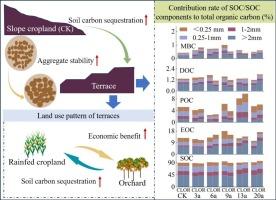Transforming slope cropland into terraced cropland to enhance the retention of labile SOC fractions by aggregates in southwestern China
IF 5.7
1区 农林科学
Q1 GEOSCIENCES, MULTIDISCIPLINARY
引用次数: 0
Abstract
Improving agricultural carbon sinks is an important approach to mitigating climate change and ensuring grain security. The converting of slope cropland into terraced cropland is an effective measure to promote the development of agriculture in mountainous areas. Studying the potential and mechanism of carbon sequestration of terraces assists land management strategies to address climate change. Therefore, we analyzed variations in labile SOC fractions accumulation and distribution in 132 soil aggregate samples from 3, 6, 9, 13, and 20 years of terrace development (rainfed cropland (CL) and orchard (OR)) and slope cropland in the Sichuan Basin. We observed that the contribution rate of SOC fraction to SOC was the highest in aggregates with >2 mm (0.6 %–28.2 %). Over 20 years, the SOC and labile SOC fractions of terraces initially decreased, then increased, and finally gradually declined. Compared with slope cropland, the dissolved organic carbon (DOC), particulate organic carbon (POC), and microbial biomass carbon (MBC) in the aggregates of terraces increased by 1.5 %, 2.3 % and 28. 8 %. Compared with OR, CL promotes the content of SOC, EOC, DOC and MBC in aggregates, increased by 6.1 %, 3.6 %, 3.6 %, and 28.6 %, respectively. Age, aggregate stability, and the interaction between age and land use patterns were the main factors for SOC accumulation. Path analysis indicated that both soil physical properties and aggregate stability have significant influences on SOC accumulation, with total effects of 0.6 and 0.7, respectively, whereas temperature and precipitation reduced sequestration (total effect = −0.2). Therefore, terracing promotes the physical protection of labile SOC fractions by aggregates, and contributes to the improvement of the agricultural carbon sink.

坡耕地转梯田增强西南地区团聚体对土壤有机碳的保留作用
改善农业碳汇是减缓气候变化、保障粮食安全的重要途径。退坡还田是促进山区农业发展的一项有效措施。研究梯田固碳的潜力和机制有助于制定应对气候变化的土地管理策略。因此,我们分析了四川盆地阶地(旱地和果园)和坡地3、6、9、13和20年的132个土壤团聚体样品中稳定有机碳组分的积累和分布变化。土壤有机碳组分对土壤有机碳的贡献率在2 mm团聚体中最高(0.6% ~ 28.2%)。20 a来,梯田土壤有机碳和稳定有机碳分数呈先降低后升高的趋势,最后逐渐降低。与坡地相比,梯田团聚体中溶解有机碳(DOC)、颗粒有机碳(POC)和微生物生物量碳(MBC)分别增加了1.5%、2.3%和28%。8%。与OR相比,CL提高了团聚体中SOC、EOC、DOC和MBC含量,分别提高了6.1%、3.6%、3.6%和28.6%。年龄、骨料稳定性以及年龄与土地利用方式的交互作用是影响土壤有机碳积累的主要因素。通径分析表明,土壤物理性质和团聚体稳定性对有机碳积累均有显著影响,总效应值分别为0.6和0.7,而温度和降水降低了固碳(总效应值为−0.2)。因此,梯田促进了团聚体对活性有机碳组分的物理保护,有助于提高农业碳汇。
本文章由计算机程序翻译,如有差异,请以英文原文为准。
求助全文
约1分钟内获得全文
求助全文
来源期刊

Catena
环境科学-地球科学综合
CiteScore
10.50
自引率
9.70%
发文量
816
审稿时长
54 days
期刊介绍:
Catena publishes papers describing original field and laboratory investigations and reviews on geoecology and landscape evolution with emphasis on interdisciplinary aspects of soil science, hydrology and geomorphology. It aims to disseminate new knowledge and foster better understanding of the physical environment, of evolutionary sequences that have resulted in past and current landscapes, and of the natural processes that are likely to determine the fate of our terrestrial environment.
Papers within any one of the above topics are welcome provided they are of sufficiently wide interest and relevance.
 求助内容:
求助内容: 应助结果提醒方式:
应助结果提醒方式:


